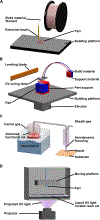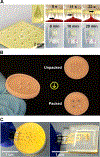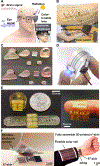Emerging Additive Manufacturing Methods for Wearable Sensors: Opportunities to Expand Access to Personalized Health Monitoring
- PMID: 40851853
- PMCID: PMC12369637
- DOI: 10.1002/adsr.202300137
Emerging Additive Manufacturing Methods for Wearable Sensors: Opportunities to Expand Access to Personalized Health Monitoring
Abstract
Persistent disparities exist in access to state-of-the-art healthcare disproportionately affecting underserved and vulnerable populations. Advances in wearable sensors enabled by additive manufacturing (AM) offer new opportunities to address such disparities and enhance equitable access advanced diagnostic technologies. Additive manufacturing provides a pathway to rapidly prototype bespoke, multifunctional wearable sensors thereby circumventing existing barriers to innovation for resource-limited settings imposed by the need for specialized facilities, technical expertise, and capital-intensive processes. This review examines recent progress in the additive manufacture of wearable platforms for physiological health monitoring. Supported by an initial overview of relevant techniques, representative examples of 3D printed wearable sensors highlight the potential for measuring clinically-relevant biophysical and biochemical signals of interest. The review concludes with a discussion of the promise and utility of additive manufacturing for wearable sensors, emphasizing opportunities for expanding access to vital healthcare technology and addressing critical health disparities.
Keywords: 3D printing; Additive manufacturing; healthcare devices; personalized medicine; wearable sensors.
Figures





Similar articles
-
Toward a Disruptive "Click-and-Run" 3D Printing Concept for Manufacturing Epidermal Wearable Electrochemical Sensors.ACS Sens. 2025 Aug 7. doi: 10.1021/acssensors.5c00682. Online ahead of print. ACS Sens. 2025. PMID: 40772346 Review.
-
Recent Advancements in Wearable Hydration-Monitoring Technologies: Scoping Review of Sensors, Trends, and Future Directions.JMIR Mhealth Uhealth. 2025 Jun 13;13:e60569. doi: 10.2196/60569. JMIR Mhealth Uhealth. 2025. PMID: 40513095 Free PMC article.
-
Harnessing the potential of emerging additive manufacturing technologies as a game-changer for chemical and biosensing innovations.Rep Prog Phys. 2025 Aug 14;88(8). doi: 10.1088/1361-6633/adf7ba. Rep Prog Phys. 2025. PMID: 40763768 Review.
-
Prescription of Controlled Substances: Benefits and Risks.2025 Jul 6. In: StatPearls [Internet]. Treasure Island (FL): StatPearls Publishing; 2025 Jan–. 2025 Jul 6. In: StatPearls [Internet]. Treasure Island (FL): StatPearls Publishing; 2025 Jan–. PMID: 30726003 Free Books & Documents.
-
Wearable sensor data visualization for patient monitoring and management: a Cancer Wellness application in Vietnam.Future Sci OA. 2025 Dec;11(1):2541522. doi: 10.1080/20565623.2025.2541522. Epub 2025 Aug 2. Future Sci OA. 2025. PMID: 40753447 Free PMC article.
References
-
- Tan M, Xu Y, Gao Z, Yuan T, Liu Q, Yang R, Zhang B, Peng L, Advanced Materials 2022, 2108491. - PubMed
-
- Lou Z, Wang L, Jiang K, Wei Z, Shen G, Materials Science and Engineering: R: Reports 2020, 140, 100523.
Grants and funding
LinkOut - more resources
Full Text Sources
